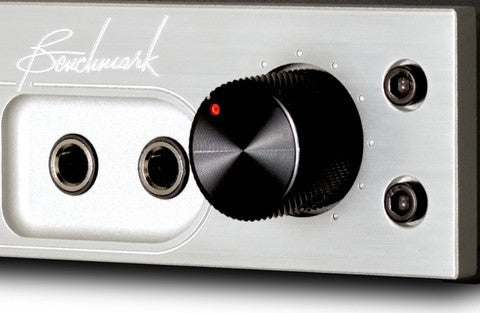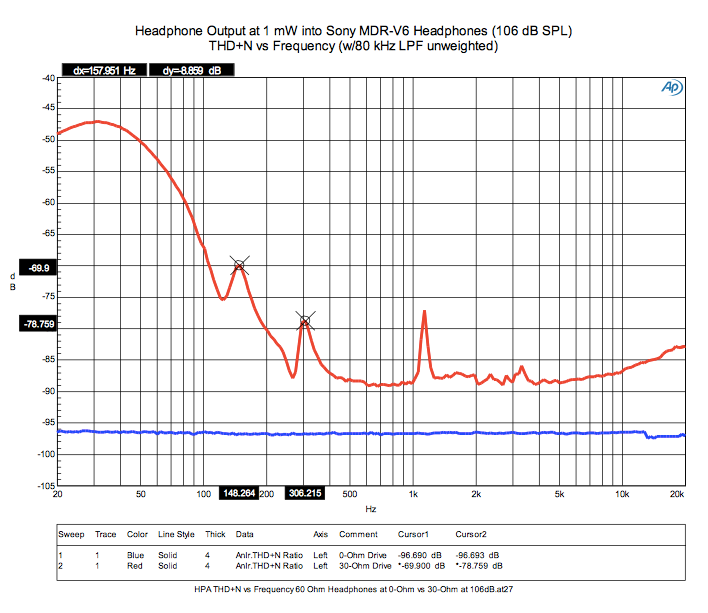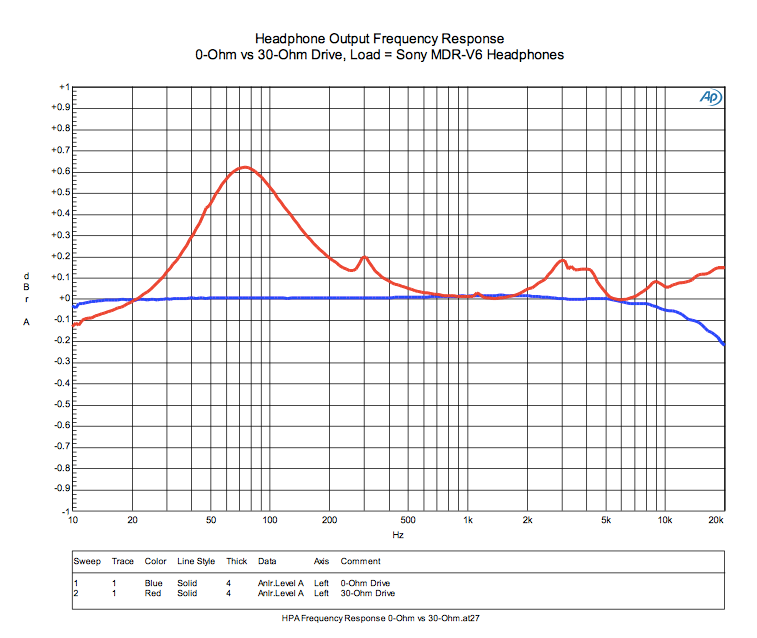Buy 2 components and get 4 free cables. Free shipping on all orders over $700.
Headphone Amplifiers - Part 2
by John Siau March 20, 2014

Headphone Amplifiers - Part 2
It's all about control!
The movement of headphone transducers must be well controlled in order to produce high-quality audio. It is easy to build a headphone amplifier that produces sound. It is an entirely different matter to produce an amplifier that is clear, clean, and enjoyable.
Headphone amplifiers need power and accuracy to achieve control. They also need to be protected from short circuits and overload conditions. The cheap, dirty, and common way to protect the amplifier is to add a series resistor between the amplifier and the headphone jack. This simple solution protects the amplifier from short circuits and overloads. Unfortunately, the resistor isolates the headphones from the amplifier, causing a loss of control. This series resistor is a big mistake.
While it's true that a series resistor can protect a headphone amplifier and keep it stable, there are some massive trade-offs. The series resistor introduces high distortion, poor frequency response, and poor phase response. Relatively low amounts of these defects may be acceptable, but our tests show that these defects can increase to objectionable levels when headphones are driven through series resistors.
If the series resistor is removed, high-demands are placed on the headphone amplifier. It must survive short circuits, and overloads. It must also remain stable when driving the dynamic load of moving headphone transducers. The direct-drive solution demands a small and robust power amplifier. Benchmark's HPA2™ is a small well-protected power amplifier that is stable when directly driving the most difficult headphone loads. The HPA2™ completely eliminates the series output resistor.
Today's state-of-the-art headphone amplifiers, such as the HPA2™ , are often called "0-Ohm" headphone amplifiers. These new high-end designs are essentially miniature power amplifiers, which provide outstanding control of the moving transducers in a set of headphones. These "0-Ohm" designs eliminate the series resistor, and provide direct drive to the headphones. This important change reduces distortion and flattens the frequency response when driving a headphone. Our lab measurements confirm the effectiveness of "0-Ohm" amplifiers.

The figure above shows distortion versus frequency. The blue line is measured at the input to a set of headphones driven directly from a "0-Ohm" amplifier. The red line is measured at the input of the same set of headphones when a 30-Ohm resistor is inserted between the amplifier and the headphones (simulating a low-cost amplifier). The series resistor causes a very significant increase in distortion (as shown by the red line).

Finally, look at this figure, above. It's a common frequency response plot. Again, the blue line is the 0-Ohm amplifier from the HPA2™ and the red line is the same amplifier running through a 30-Ohm series resistor. The figures really speak for themselves. A "0-Ohm" amplifier maintains control of the headphone frequency response. In contrast, the series resistor creates a filter when loaded by headphones. This unintended filter changes the frequency response of the headphones.
If you're interested in learning more about "0-Ohm" headphone amplifiers, we've written a white paper with all the relevant information and measurements. This paper provides measurements which demonstrate the significant advantages of headphone amplifiers with very low (near 0-Ohm) output impedances. A low output-impedance increases the damping factor of the amplifier-headphone system. "The 0-Ohm Headphone Amplifier" white paper by John Siau shows that a low output-impedance reduces distortion while improving frequency and phase response.
- John Siau
Recommended reading:
More information on headphones and headphone amplifiers can be found here.
Also in Audio Application Notes

Audiophile Snake Oil
by John Siau April 05, 2024
The Audiophile Wild West
Audiophiles live in the wild west. $495 will buy an "audiophile fuse" to replace the $1 generic fuse that came in your audio amplifier. $10,000 will buy a set of "audiophile speaker cables" to replace the $20 wires you purchased at the local hardware store. We are told that these $10,000 cables can be improved if we add a set of $300 "cable elevators" to dampen vibrations. You didn't even know that you needed elevators! And let's not forget to budget at least $200 for each of the "isolation platforms" we will need under our electronic components. Furthermore, it seems that any so-called "audiophile power cord" that costs less than $100, does not belong in a high-end system. And, if cost is no object, there are premium versions of each that can be purchased by the most discerning customers. A top-of-the line power cord could run $5000. One magazine claims that "the majority of listeners were able to hear the difference between a $5 power cable and a $5,000 power cord". Can you hear the difference? If not, are you really an audiophile?

Making Sound with Plasma - Hill Plasmatronics Tweeter
by John Siau June 06, 2023
At the 2023 AXPONA show in Chicago, I had the opportunity to see and hear the Hill Plasmatronics tweeter. I also had the great pleasure of meeting Dr. Alan Hill, the physicist who invented this unique device.
The plasma driver has no moving parts and no diaphragm. Sound is emitted directly from the thermal expansion and contraction of an electrically sustained plasma. The plasma is generated within a stream of helium gas. In the demonstration, there was a large helium tank on the floor with a sufficient supply for several hours of listening.

While a tank of helium, tubing, high voltage power supplies, and the smell of smoke may not be appropriate for every living room, this was absolutely the best thing I experienced at the show!
- John Siau

Audio Calculators
by John Siau June 04, 2023
We have added an "Audio Calculators" section to our webpage. Click "Calculators" on the top menu to see more like these:

